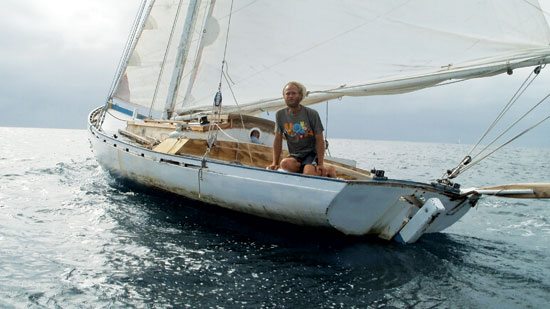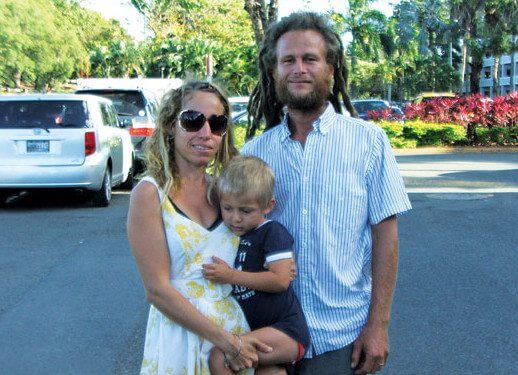Around four years ago, I had something of an epiphany; I realized we must move to Brazil. This decision came after careful analysis of our – my wife Christina, our son Gaston and me – future on this rapidly changing planet. We would sell the micro farm I had built up in Vieques, Puerto Rico, and start again over there. For most of my life I have lived on, and owned boats. Now we had to find another one and sail her to Brazil. With such a mobile home we would have all the time in the world to carefully explore the country’s immense coastline and find the perfect place for us.

I started looking for a sailboat that could carry us there safely and smartly. I searched the usual classifieds, walked the docks. I was even offered a boat for free, but all were too expensive, needed too much work, were too weak for a long ocean passage or promised poor windward performance.
I have always much admired working sailboats, or boats closely modeled after them. In Puerto Rico there is a style of native sloop that are today used for racing but were originally built as fishing boats. They are noted for their exceptional turn of speed and ease of handling. While I was mulling over my options in Las Croabas on the east coast of Puerto Rico, some older gentlemen let me know that the 34ft Oasis was for sale.
Now it so happens that, ever since I was a teenager in Puerto Rico, the Oasis has been my favorite of all the racing sloops. She has the fairest lines of all the nativos and the most moderate proportions, as well as consistently beating all the others in races and being very well built.
I hurried to see the owner. He proceeded to ‘interview’ me at length to see if I was worthy of this piece of Puerto-Rican heritage.
Eventually we came around to the negotiating. He declared $12,000, but I was determined to get her for $10,000, as all I had was 12k and I knew perfectly well that I would have things to buy if I wanted to use her for ocean sailing. In fact, I had already withdrawn the 10k and put all the bills in a cigar box. I proceeded to show him the cash, emphasizing that it was all I had. His eyes opened noticeably wider, yet the wily seller still attempted to get me to agree to pay the difference in installments, which I refused on the principle of never being in debt.
We sealed the deal and as soon as I had the notarized bill of sale in my hand, I upped anchor and sailed Oasis back to Vieques, as the port of Naguabo is wide open and hurricane Earl was due to strike the following afternoon. Don Gelo, Oasis’ builder, confided in me later that had I not bought her then, the boat would most likely have been lost on the beach.
These boats are normally sailed with large crews and sandbags to counterbalance the enormous spread of sail they sport for racing, but I was going to be doing a much more conservative form of sailing altogether so I had some modifications to do. It proved quite impractical to get any work done where we lived as our house is on the north side of Vieques while the safe harbors are on the south side of the island. Fortunately, Don José, the father of a good friend of ours, generously allowed us to use his house while we finished the work. It lay just a few hundred feet from the fully protected anchorage of Guayama.

Christina and I, with some help from young Gaston, loaded the Oasis up with food, clothes, all my tools, a vast pile of lumber and the same generator I had used to build our house. As I had already discovered prior to buying the boat, the wood around the chainplates was badly rotted, due to a poorly executed modification that had been done some years previously. Therefore, I sailed downwind to Guayama, cautiously, under jib only and with a favorable forecast, yet I was still quite nervous each time a larger set of waves livened up our rolling, as I could see the chainplates pulling the planks inwards …
First thing was to replace the chainplate supports, quickly followed by installing a sturdy hardwood Samson post, through bolted to one of the floors. The hurricane zone is no place for rinky-dink anchoring gear! I also bought a 15kg Bruce anchor and a generous amount of three-quarter inch nylon rode to replace the rusty and bent Danforth that came with the boat. In addition, I had the trusty stainless steel Northill anchor I had salvaged off of my father’s shipwrecked boat. I lowered the original floorboards to just 15cm above the lead ballast, leaving just enough space for stashing a secondary reserve of food. I completed the floorboards all the way forward, and all the way aft, which would become our berth. Forward, fairly high up the side, I made a bunk for four-year-old Gaston, with some steps leading up to it and a bunk board so he would not fall out. I also made a large sculling oar for pushing the nine tons of boat along when sailing was not an option. Oasis has no engine, and fitting one would not only be very difficult and expensive, but also ruin her superb sailing qualities. It would also be of questionable profit given the very few occasions on which I might be inclined to use it.
There is a sunken sailboat in Guyama harbor with just the mast sticking out of the water at 30 degrees to the vertical. This was ideal for lifting out Oasis’ mast. I climbed it and attached a solid purchase to the top, leaving the end hanging down. I sailed Oasis across the lagoon and anchored with two anchors at each end so she could not move and then bent the purchase to where I guessed the center of gravity of my 56ft mast would be. Apparently, the mast had never been taken out since it was stepped, because I ended up putting a three to one purchase on the five to one purchase I had already set up, and then two of us started swinging on it (it ended up being about 150 to 1) and still the mast would not budge! I swear it seemed the boat itself was starting to lift a little in the water. After an hour or so of that nonsense, I started up the generator and went down below with the angle grinder. Three worn out discs later and the severed mast sprang up a good meter, almost shooting right out of its hole.
Then followed the joy of removing all the old stainless steel hardware with hundreds of screws welded tight with corrosion—only five screws did not shear off. There was only so much I could do per day as the huge effort would tear the calluses off my hands.
I cut eight feet off each end of the mast and fashioned wood/epoxy plugs for each end. I had already made the fourteen foot gaff. I cut eight feet off the 37-foot long boom too. I took advantage of having the mast on deck to sand it and put two coats of urethane on the upper section, which is harder to do once it’s in position.
It had always been our plan to have a second child but for immigrating to Brazil it is a crucial tactical advantage to be the parents of a Brazilian. Therefore we were trying to time it so that our second child would be born soon after our arrival there. However, things aren’t necessarily that simple in practice …
In August my beautiful wife says, “Surprise … I’m pregnant!” and I thought ‘Good … but it was not supposed to be yet!’ This meant we had six months (to have three months margin) to finish all the work, haul the boat out and sail to Brazil. Two thousand five hundred miles dead to windward.
Ok, ok, don’t panic, just get on with it, man!
I made a coachroof that fit over the existing opening in the deck, hatches fore and aft and a main entrance hatch. Then built a galley right in the entrance so I could stand up as well as allowing the hot air from the stove to easily escape. A rustic, but sturdy, setup was made to secure all our stuff below on either side of a narrow central passageway. Some basic wiring for the bilge pump, some LEDs and a 110V inverter, completed the electrics.
Finally, after re-stepping the mast and re-rigging her, there were the sails to cut to the new shape and a dinghy to build. For the sails, I used contact cement. In four days, both sails were reincarnated. From the original 1150 square feet I reduced it to 850 square feet of sail area. The triangle I cut off the top of the mainsail I kept to eventually make a topsail.
If I had managed to gather a small fee for every time I was told that sailing from Puerto Rico to Brazil is impossible, I would be comfortably off by now.
So, just how impossible is it?
Next month! In part two of this three part series, Thomas Tangvald and his young family sail south through the Caribbean.




